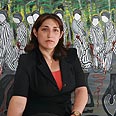
Buteina Halabi. 'These paintings are my thoughts and feelings'
צילום: שאול גולן
Painting a different kind of memory
What makes a Druze artist from Daliyat al-Karmel dedicate her work to the Holocaust? Noah Klieger meets with Buteina Halabi in search of an answer
Had I written that Buteina Halabi was a painter, it would have been like writing that Paris is just a regular, charmless city. True, she is a painter, but a unique one. To be exact, she is one of a kind. Because most of the paintings created by this young Druze woman are dedicated to the Holocaust.
And on this level at least she is indeed unique, and there is no wonder she has acquired a reputation way beyond the borders of Daliyat al-Karmel, the community she was born in and works in, and way beyond the borders of the State of Israel.
Moreover, in the past two years buses carrying visitors from Israel and across the world have been arriving at the northern town to observe her work.
Buteina is not unique just in terms of the theme of her paintings, but also in the fact that she does not sell any of her work dedicated to the Holocaust.
"These paintings are like my thoughts and my feelings," she explains, "and one doesn't sell one's thoughts and feelings." Her husband, Tamir, 36, is present during the interview and appears to agree with her.
And how did the 36-year-old Druze painter come to deal with the Holocaust issue? "In April 2008 I read Yedioth Ahronoth's Holocaust supplement, and when I saw a number of photos from those horrible times I suddenly had this strong gut feeling that I must devote time and energy to this inconceivable and tragic period in the history of the Jewish people, the people with whom I live."
First of all, she says, she began studying the subject by reading and watching documentaries and visiting the Yad Vashem Holocaust museum several times.
"When I looked at the photos in the museum's commemoration site, I also got the inspiration for the motifs I wanted to draw." Indeed, many of her large oil paintings are based on those motifs, in a slightly figurative and slightly abstract style. Drawings that talk to you, that "catch you by the throat".
Buteina and Tamir Halabi have three children, two girls and a boy. The family lives in a large and spacious two-story home. When I tell them that they still have to make a living, especially with all the visitors they receive with great hospitality, the two calm me down.
"We both work, in coordination with the community's Education Department, in schools and different classes," Tamir says. Buteina teaches art while he organizes and runs the different classes.
"This year we had close to 400 pupils," the couple says with clear satisfaction. They plan to build a museum in their front yard, where Buteina's work will be displayed.
"Then we'll be able to ask for a symbolic admission fee in order to cover some of the expenses for the refreshments we serve," Tamir says, adding that in the meantime "I don't have the money to build that structure."
'Holocaust denial a crime'
Buteina began showing an interest in painting when she was in high school. "Although I never studied painting, I began drawing with charcoal and was surprised when everyone liked my work," she says with a huge smile.
When she married Tamir she took a break from painting, and resumed her hobby after her eldest daughter, 11-year-old Eva, was born.
"Tamir really encouraged me, as did my brother-in-law Lutafi Nasralladin, who was killed in Operation Cast Lead in Nahal Oz. Lutafi was also the first person who told me that we Druze must learn more about the Holocaust our Jewish brothers suffered from."
Buteina, who has presented her work in six exhibitions in Israel, takes pride in the fact that Yad Vashem agreed to display one of her paintings ("The Last Letter") and that last year she took part in a delegation of Holocaust survivors who attended the International Holocaust Day ceremony in Transylvania, Romania.
"I was very excited on that trip," she says. "We visited Romania's only Holocaust museum, inside a deserted synagogue, because there are no more Jews left in that area."
She adds proudly that she lit one of the torches and was asked to address the crowd. "I chose to talk about the crime of Holocaust denial."
She was also very moved by the visit to Sighet, where Elie Wiesel was born and raised. "We saw the house where he lived with his family," she says.
Buteina Halabi is definitely an unusual painter. My old friend Fuad Birani, a neighbor of the Halabi family, was right to tell me that "Buteina is the pride of the Druze community." That is so true.










